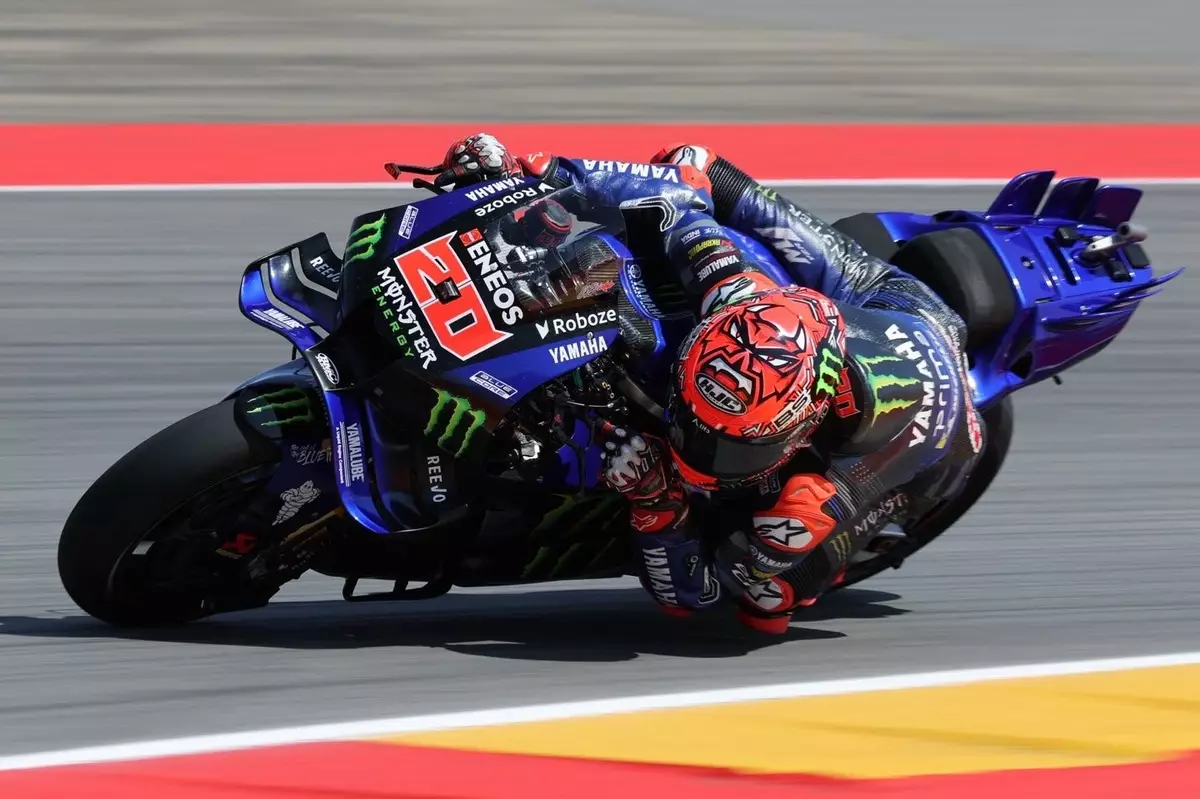Revealing the Crippling Grip Crisis: Yamaha’s YZR-M1 Struggles at Aragon
In the world of MotoGP, every race is a high-stakes drama played out on tracks that test the limits of man and machine. The Aragon track, with its notorious grip conditions, has long been a battlefield where only the most finely-tuned machines emerge victorious. For Yamaha’s YZR-M1, however, this year’s race at Aragon was less a triumph and more an encounter with harsh realities. Watching Fabio Quartararo wrestle with his bike was like witnessing a seasoned dancer struggling with an uncooperative partner.
This wasn’t how it was supposed to go for Yamaha and Quartararo. The team’s hopes were pinned on their star rider overcoming the challenges that have consistently dogged them at this circuit. Yet, as Friday’s practice unfolded, their aspirations appeared to crumble under the weight of persistent grip issues. Instead of dominating the asphalt, Quartararo found himself fighting against it, leading to a performance that fell short of expectations and left fans and analysts alike questioning what went wrong.
The statistics told a story that Yamaha couldn’t ignore. Quartararo’s speeds were significantly lower than his competitors’, underscoring a critical power delivery problem. On a track where grip is king, Yamaha’s struggle became the talk of the paddock. As Quartararo valiantly tried to push through these challenges, one couldn’t help but empathize with him as he grappled not just with physical constraints but also with the mental toll of unmet expectations.
Key Takeaways
- Yamaha’s YZR-M1 faces significant grip issues at the Aragon track.
- Fabio Quartararo’s performance highlights deficiencies in power delivery.
- Team morale is impacted by technical challenges and psychological pressures.
- Yamaha must urgently address these issues to remain competitive.
Frantic Measures and Frustrations
Quartararo’s body language during practice was telling; it spoke volumes about his frustration with the YZR-M1’s performance. Each lap seemed to chip away at his confidence, as hand gestures and tense postures replaced what should have been seamless maneuvers. After dismounting from his bike, instead of strategizing with his team immediately, he chose to find solitude—a telling sign of the stress elite athletes endure when faced with equipment that doesn’t deliver.

Despite these challenges, Quartararo managed to keep his sense of humor intact when speaking to the media. His quip about nearly making pole position from the back of the grid was both amusing and revealing. It highlighted not just his resilience but also the deep-seated frustration of being unable to extract full potential from his machine. Humor aside, it was clear that beneath his smile lay an athlete eager to return to winning ways.
Examining the Root Causes
The day brought about many questions regarding Yamaha’s electronic systems. Quartararo hinted at these in interviews, suggesting that changes in tire compounds wreaked havoc on their electronics—a poignant reminder of how intricate modern racing technology is. In MotoGP, even minor adjustments can lead to significant performance shifts. It’s a delicate dance between technology and human capability that requires precision in both understanding and execution.
Massimo Meregalli, Yamaha’s team director, echoed these sentiments during debriefs. He pointed out that both Quartararo and teammate Alex Rins faced similar rear grip issues—an indication that this isn’t an isolated incident but part of a larger problem affecting their bikes across different circuits. Such insights from Meregalli underline the scope of Yamaha’s struggle while simultaneously casting doubt on their ability to adapt swiftly enough to changing conditions.
The Urgent Need for Solutions
Time is not on Yamaha’s side as they scramble for solutions that could transform their fortunes at Aragon and beyond. This situation underscores not just technical hurdles but also the broader narrative of perseverance against adversity in competitive racing. In MotoGP, where fractions of seconds separate victors from vanquished, grip isn’t merely a technical term—it’s an essential element that shapes outcomes.

The pressing question now is whether Yamaha can rise above these recurring challenges or continue down this path fraught with difficulties. As every second counts down towards race day, Quartararo’s hopes for redemption lie not just in mechanical tweaks but also in mental fortitude. It’s a race against time where Yamaha finds itself confronting both external rivals on track and internal battles within their own ranks.
Final Thoughts
As we look forward to seeing how Yamaha addresses their grip crisis at Aragon, it’s important to remember that racing is as much about overcoming challenges as it is about celebrating victories. The resilience displayed by Fabio Quartararo amidst these setbacks speaks volumes about his character as a racer. For Yamaha, finding solutions will require not just technical innovation but also strategic foresight and teamwork.
The outcome at Aragon may set the tone for future races in this season’s championship journey. As fans eagerly await improvements and results from Yamaha’s camp, one thing remains clear: overcoming adversity is part of what makes motorsport thrilling—where each race brings new opportunities for growth and triumph over trials faced along pit lanes around the world.
MotoGP
Yamaha YZR-M1
Fabio Quartararo
Aragon Track


Leave a Reply